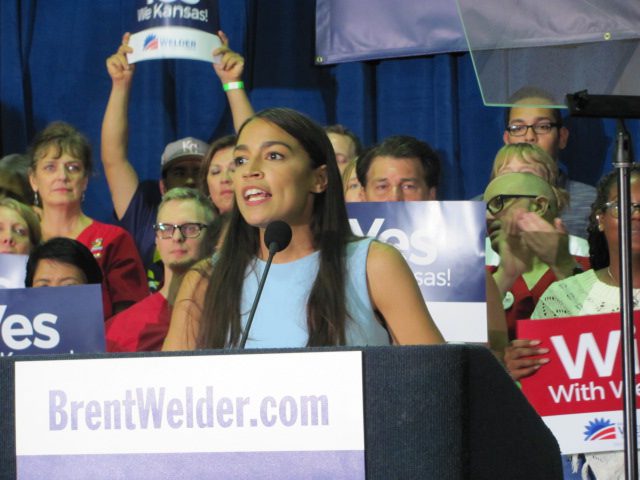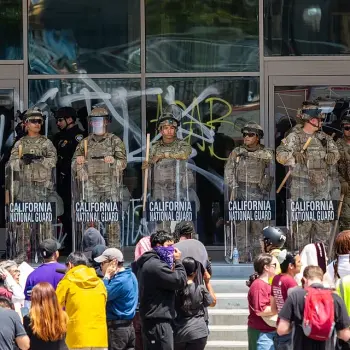The far left wing of the Democratic-controlled Congress has been pushing something called the Green New Deal. As a proposal to deal with climate change and other environmental issues, it has been around for awhile, particularly in Europe. But this Congressional proposal being championed by the new socialist congresswoman Alexandria Ocasio-Cortez (D-NY) adds to the “Green” environmental policies, a plan to establish gender & racial equality and “eliminate poverty” (with job guarantees, providing a basic income to all, universal health care, etc.).
Rep. Ocasio-Cortez has made a proposal for the House of Representatives to establish a special committee to draw up legislation towards these ends, to the point of staging a sit-in in Speaker Nancy Pelosi’s office. The Speaker, in line with more cautious Democrats, said “no,” but agreed to re-open the House Select Committee on Climate Change, which could be used for the Green New Deal.
Meanwhile, the Green New Deal is being embraced as a manifesto by the far left wing of the Democratic Party. Activists are saying they may use it as a litmus test for presidential candidates. Presidential hopefuls Cory Booker, Bernie Sanders, and Elizabeth Warren have already endorsed it.
Here is the outline of the plan, from Rep. Ocasio-Cortez’s proposal:
(6) SCOPE OF THE PLAN FOR A GREEN NEW DEAL AND THE DRAFT LEGISLATION.—
(A) The Plan for a Green New Deal (and the draft legislation) shall be developed with the objective of reaching the following outcomes within the target window of 10 years from the start of execution of the Plan:
- Dramatically expand existing renewable power sources and deploy new production capacity with the goal of meeting 100% of national power demand through renewable sources;
- building a national, energy-efficient, “smart” grid;
- upgrading every residential and industrial building for state-of-the-art energy efficiency, comfort and safety;
- eliminating greenhouse gas emissions from the manufacturing, agricultural and other industries, including by investing in local-scale agriculture in communities across the country;
- eliminating greenhouse gas emissions from, repairing and improving transportation and other infrastructure, and upgrading water infrastructure to ensure universal access to clean water;
- funding massive investment in the drawdown of greenhouse gases;
- making “green” technology, industry, expertise, products and services a major export of the United States, with the aim of becoming the undisputed international leader in helping other countries transition to completely greenhouse gas neutral economies and bringing about a global Green New Deal.
(B) The Plan for a Green New Deal (and the draft legislation) shall recognize that a national, industrial, economic mobilization of this scope and scale is a historic opportunity to virtually eliminate poverty in the United States and to make prosperity, wealth and economic security available to everyone participating in the transformation. In furtherance of the foregoing, the Plan (and the draft legislation) shall:
-
- provide all members of our society, across all regions and all communities, the opportunity, training and education to be a full and equal participant in the transition, including through a job guarantee program to assure a living wage job to every person who wants one;
- diversify local and regional economies, with a particular focus on communities where the fossil fuel industry holds significant control over the labor market, to ensure workers have the necessary tools, opportunities, and economic assistance to succeed during the energy transition;
- require strong enforcement of labor, workplace safety, and wage standards that recognize the rights of workers to organize and unionize free of coercion, intimidation, and harassment, and creation of meaningful, quality, career employment;
- ensure a ‘just transition’ for all workers, low-income communities, communities of color, indigenous communities, rural and urban communities and the front-line communities most affected by climate change, pollution and other environmental harm including by ensuring that local implementation of the transition is led from the community level and by prioritizing solutions that end the harms faced by front-line communities from climate change and environmental pollution;
- protect and enforce sovereign rights and land rights of tribal nations;
- mitigate deeply entrenched racial, regional and gender-based inequalities in income and wealth (including, without limitation, ensuring that federal and other investment will be equitably distributed to historically impoverished, low income, deindustrialized or other marginalized communities in such a way that builds wealth and ownership at the community level);
- include additional measures such as basic income programs, universal health care programs and any others as the select committee may deem appropriate to promote economic security, labor market flexibility and entrepreneurism; and
- deeply involve national and local labor unions to take a leadership role in the process of job training and worker deployment.
(C) The Plan for a Green New Deal (and the draft legislation) shall recognize that innovative public and other financing structures are a crucial component in achieving and furthering the goals and guidelines relating to social, economic, racial, regional and gender-based justice and equality and cooperative and public ownership set forth in paragraphs (2)(A)(i) and (6)(B). The Plan (and the draft legislation) shall, accordingly, ensure that the majority of financing of the Plan shall be accomplished by the federal government, using a combination of the Federal Reserve, a new public bank or system of regional and specialized public banks, public venture funds and such other vehicles or structures that the select committee deems appropriate, in order to ensure that interest and other investment returns generated from public investments made in connection with the Plan will be returned to the treasury, reduce taxpayer burden and allow for more investment.
How to pay for all of this? Rep. Ocasio-Cortez is floating a 70% tax on the wealthy. Would that be nearly enough to do all of this? Do we have enough wealthy people to pay for a guaranteed minimum income for all Americans and universal healthcare for all? If we do have enough wealthy people, would we for very long if we are going to confiscate so much of their income? Of course, the bigger agenda is to create a “new economy,” replacing free market capitalism with social-democratic-style socialism.
What do you think of these proposals? Here is an argument for the Green New Deal, and here is an argument against it.
I would like to focus on just one: Meeting 100% of our energy needs with renewal sources within 10 years. This would be creating new technology by decree. That passing a law could suddenly bring into existence new non-polluting, renewable energy for all of our needs reflects the “constructivist” mindset to an extreme. We choose to do something, exert political power by passing a law, and, lo, it comes to pass.
This recalls the “command economy” of the Soviet Union, which sets quotas for factories and issues other dictates for the economy as a whole. This top-down approach, which requires an all-powerful government, is in contrast to the organic productivity of the free market in accord with economic laws. (Why isn’t it “Green” to favor an “organic” and natural “law” approach to economics?)
You might think that the Green New Deal is too radical to ever be imposed in the United States. But it is quite possible, given the leftist insurgence in the Democratic base, that a supporter of the Green New Deal will be the Democratic candidate for the presidency.
Normally, a hard-left candidate would not have a chance. But the 2020 election may be a referendum on Donald Trump. The president remains popular among his base, but that is not enough to re-elect him. The blue-collar industrial states of Wisconsin, Michigan, and Pennsylvania that put Trump over the top in 2016 have now reverted back to the Democrats. Trump may well beat an extremist Democratic candidate. But if people vote primarily against Trump, rather than for or against a set of policies, potentially any Democrat could conceivably beat him. And we could find ourselves living under the Green New Deal.
Photo of Alexandria Ocasio-Cortez at campaign rally by Mark Dillman [CC0], via Wikimedia Commons












